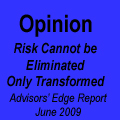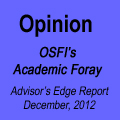There was a query in yesterday’s comments about the difference in yield between the OpRet and SplitShare Indices.
Well – some of the difference is due to the nature of the calculation, which includes the negative yields-to-worst for the Operating Retractible issues CM.PR.A (-5.44%) and PWF.PR.D (-10.30%). These two issues have the combined effect of bringing the average yield of the entire index down by 180bp … but that’s just the way the mean works.
Assiduous readers will note that in the final version of the indices, I am using median yield rather than mean, which helps a lot but has problems of its own (choppiness in an index comprised of two issues of roughly equal weights and greatly different yields, for instance).
realBoomer continues:
It seems to me that Op. Retract and Split-Shares are essentially similar investments – both pay a fixed dividend and will be redeemed at par at some date in the future. In fact, I would think a Split Share issue should be preferable to an Op. Retract issue of the same credit quality, since the Split Shares dividends and unit values are protected to some extent by the Capital Shares. Am I missing something, or is the market just irrational for Split Shares?
Well … for an introduction to the similarities and differences between the two issues, I can suggest Retractible Preferreds and Bonds and SplitShares.
The investments are in principle the same, having cash-flows that are analyzed the same way.
As far as credit quality is concerned … my article Are Floating Rate Prefs Money Market Vehicles contains a highly unscientific and subjective ratings migration table, showing the downgrades from Investment Grade to … er … not investment grade by DBRS. Be careful with the table and read the errata given in the post about the article! SplitShares are worse than the table makes them.
SplitShare ratings have historically been more volatile than operating company ratings, basically for the same reason as CDOs have more volatile ratings than regular bonds. They are dependent upon a mark to market of their underlying assets … exchange traded underlying assets. It’s not like you have a regular company, for instance, that through good years and bad owns a factory worth $100-million. DBRS is making an attempt to tighten up their standards, as I noted in a post about SBN.PR.A, which will help a lot, but basically it’s a question of visibility … it’s much easier to see that asset coverage has declined to 1.1:1 than it is to see that Weston / Loblaws is having real difficulties as opposed to a mere bad year.
Aside from rating volatility, there’s the question of hidden resources. Let’s say Quebecor gets into even more trouble than it’s in now. There’s a chance – just a chance, mind you, but it’s there – that a strategic buyer will step up to the plate and buy it for a song, sticking it to Quebecor’s common shareholders, but having to bail out the preferred shareholders because they don’t have to agree to nothing. I’m thinking of a situation, for instance, where the rational price of a Quebecor common share goes to ten cents, or something like.
If a split share corporation gets that close to the line, there ain’t no deus ex machina coming.
Even with all this, Assiduous Readers will note that Malachite Fund often owns SplitShares and much less often Operating Retractibles. Even after correcting for the funny averages, there is a very real yield difference between the two classes.
It is my unsupported, deniable, and thoroughly irrelevant belief that this yield difference is due to the nature of the market. Corporations often own preferred shares. As we learned in the ABCP fiasco, many companies – even those with nine-figure investment portfolios – do not seek professional investment advice. It’s money, right? Who does money around here? The CFO and Treasurer, right? Get cracking!
So, you have guys buying prefs without much knowledge of the market. If they squeeze out half a point more return, nobody’s going to thank them. If they have to ‘fess up that something tanked, they might lose the keys to the executive washroom. They might get fired and find that the company’s statement of defense against unjust dismissal is full of quotation marks and “Structure Investment Vehicles” and “Complex Investment Strategies” and “Covered Call Writing” using “Derivatives”.
It should also be noted that most, if not all, split share issues are rated only by one credit rating agency – DBRS. That might run afoul of generalized investment guidelines. I’m not aware of any reason why S&P wouldn’t rate SplitShares – I suspect it’s just a question of rating fees and issuers not wanting to pay them. Operating companies will generally have two ratings on their prefs (there’s something of a fad for getting three, lately); makes sense, given that they pretty well have to have at least two ratings to sell their bonds: the marginal cost is, well, marginal.
One way or another, it’s a lot safer, career-wise to buy an issue with a recognizable name on it. Nobody ever got fired for buying IBM. So – I suspect – Operating Retractible issues will trade with lower yields simply because there are more potential buyers.









































































































